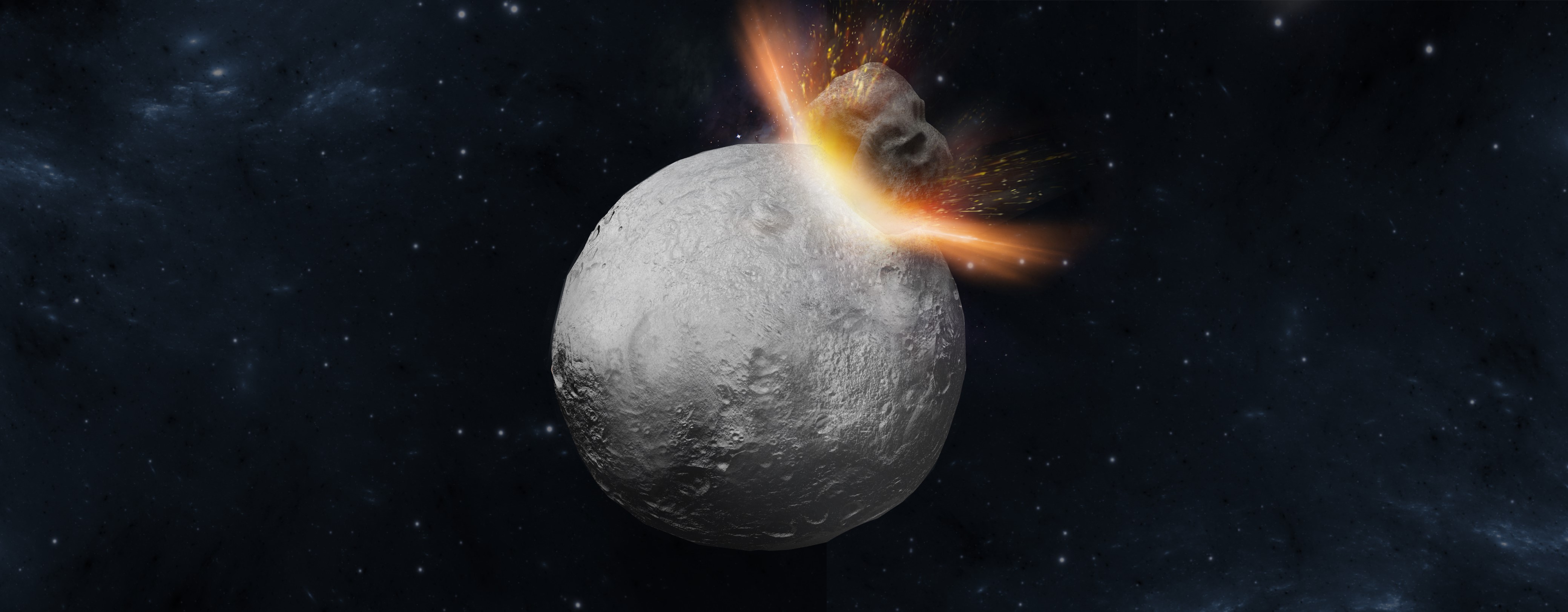Rare Meteorites on Earth Forged in Massive Crash on Asteroid Vesta

Mysterious rare meteorites made of a mix of stone and iron likely formed when Vesta, the brightest asteroid in the sky, experienced a giant impact, a new study finds.
That impact took place more than 4.5 billion years ago when a still-young Vesta and a hunk of rock about a tenth its size collided and the latter penetrated all the way to Vesta's core, the researchers argue. The resulting meteorites have let the scientists piece together a more detailed biography of the large asteroid, lead author Makiko Haba, a planetary scientist at the Tokyo Institute of Technology, told Space.com.
There are three main groups of meteorites: stony, iron and stony-iron. Stony meteorites, the largest group, formed from the outer crust of an asteroid or planet and are made up mostly of silicon-rich minerals known as silicates. Iron meteorites, the next most common kind, consist mostly of iron and nickel and formed from the core of asteroids or planets. The rarest kind of meteorite are the stony-iron meteorites, containing about equal parts of stone and iron.
Related: Photos: Asteroid Vesta and NASA's Dawn Spacecraft
One kind of stony-iron meteorite are mesosiderites, the chemistry of which suggested their ingredients came from both the stony crust and the molten metallic core of an asteroid, but oddly not the mantle layer in between, raising questions as to how that might have occurred.
Now, researchers suggest these mystery meteorites originated after a colossal impact that Vesta, the second-largest asteroid known, experienced in the early days of the solar system. "We propose a new evolutionary history for Vesta," Haba said.
The scientists analyzed five mesosiderites that were unearthed from Chile, Iowa and northwest Africa between1861 and 2014. They noted that zircon crystals in the meteorites likely formed when metals in these mesosiderites were molten. The physical features of the crystals and metals in the meteorites suggested these materials mixed in the molten core of an asteroid about 330 miles (530 kilometers) wide, matching Vesta, they said.
Get the Space.com Newsletter
Breaking space news, the latest updates on rocket launches, skywatching events and more!
Haba and her colleagues next analyzed about two dozen zircon crystals extracted from the five mesosiderites. After examining levels of uranium and lead isotopes in these zircons, they concluded that the silicates in these meteorites formed about 4.55 billion years ago and the silicates and metals mixed about 4.52 billion years ago.
The scientists proposed that after Vesta formed and cooled enough to separate into distinct crust, mantle and core layers, a rock about one-tenth the size of Vesta smashed into the asteroid. This hit-and-run collision blasted a crater on Vesta's northern hemisphere that reached all the way into the asteroid's core, they said.
Some of the debris from this impact, made up from all three of Vesta's layers, fell back onto the asteroid, mostly on Vesta's southern hemisphere, the researchers wrote. This would explain the unusually thick crust that NASA's Dawn spacecraft detected at Vesta's south pole.
A pair of overlapping impact craters seen near Vesta's south pole from two collisions — one likely occurring about 2 billion years ago, the other about 1 billion years ago — could have dislodged rocks made up of mixtures of materials from Vesta's crust and core. This would explain the mesosiderites seen on Earth, the researchers said.
"We found that this model can explain all problems regarding Vesta," Haba said. "It was a eureka moment."
All in all, "we determined the precise timing of mesosiderite formation on Vesta and demonstrated that we could reconstruct Vesta's evolution based on this chronology," Haba said. "This is a first step for us, and we will apply this concept to as many other planetary bodies as possible."
The scientists detailed their findings online today (June 10) in the journal Nature Geoscience.
- Vesta Up Close: What the Dawn Probe Revealed
- Photos: Asteroids in Deep Space
- NASA Probe Snaps Stunning New Pics of Dwarf Planet Ceres
Follow Charles Q. Choi on Twitter @cqchoi. Follow us on Twitter @Spacedotcom and on Facebook.
Join our Space Forums to keep talking space on the latest missions, night sky and more! And if you have a news tip, correction or comment, let us know at: community@space.com.

Charles Q. Choi is a contributing writer for Space.com and Live Science. He covers all things human origins and astronomy as well as physics, animals and general science topics. Charles has a Master of Arts degree from the University of Missouri-Columbia, School of Journalism and a Bachelor of Arts degree from the University of South Florida. Charles has visited every continent on Earth, drinking rancid yak butter tea in Lhasa, snorkeling with sea lions in the Galapagos and even climbing an iceberg in Antarctica. Visit him at http://www.sciwriter.us









